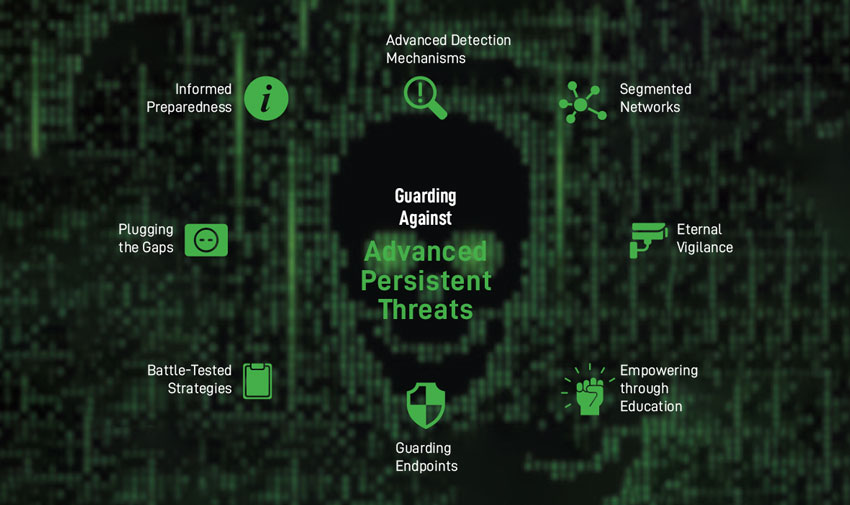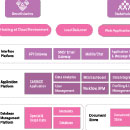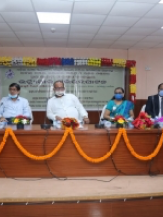In the digital age, Advanced Persistent Threats (APTs) pose a persistent and evolving menace. APTs, orchestrated by adept adversaries, demand advanced defense strategies, including cutting-edge detection tools, network segmentation, vigilant monitoring, employee education, regular updates, endpoint security, incident response planning, and informed threat intelligence. By embracing these measures, we can fortify our digital realm against Advanced Persistent Threat’s stealthy advances.
In today’s interconnected digital world, where technology has seamlessly integrated into every aspect of our lives, a looming threat emerges – Advanced Persistent Threats (APTs). These highly sophisticated and persistent cyberattacks have become a pressing concern, urging both organisations and individuals to strengthen their defences. In this article, we embark on a journey to unveil the intricate layers of APTs, their tactics, and the vital measures needed to counter their stealthy incursions.
Exploring the APT Landscape
At its core, an Advanced Persistent Threat (APT) refers to a meticulously orchestrated cyberattack campaign where intruders establish a clandestine, long-term presence within a network. These attacks are not random; they are strategically planned and meticulously researched. The primary targets often include large enterprises or government networks, and the consequences of such intrusions are far-reaching
- Intellectual Property Theft: APTs frequently aim to pilfer trade secrets, patents, and proprietary information
- Compromised Sensitive Information: Employee and user private data are prime targets, leading to severe privacy breaches
- Sabotage of Critical Infrastructures: APTs can disrupt and even destroy essential organizational systems, such as database deletion, causing significant disruptions
- Total Site Takeovers: In some instances, attackers gain complete control over a victim’s digital presence, posing a grave threat
Executing an APT assault demands substantial resources, including skilled cybercriminal teams with significant financial backing. Some APT attacks are even state-sponsored, used as potent weapons in the realm of cyber warfare.
APTs vs. Traditional Cyber Threats
APTs differ significantly from conventional web application attacks in several key ways:
- Complexity: APTs are notably more complex and sophisticated in their execution
- Persistence: Unlike hit-and-run attacks, APTs maintain a long-term presence within compromised networks to gather extensive information
- Manual Execution: APTs are manually executed against specific targets, contrasting with automated attacks launched indiscriminately
- Network-Wide Infiltration: APTs aim to infiltrate entire networks, not just isolated segments
APT Progression
A successful APT attack unfolds in three distinct stages: network infiltration, expansion of the attacker’s presence, and the extraction of amassed data—all while avoiding detection
- Stage 1 – Infiltration: Enterprises typically fall victim to infiltration through one of three attack surfaces: web assets, network resources, or authorized human users. Attackers achieve this through malicious uploads (e.g., Request for Information (RFI), SQL injection) or social engineering attacks like spear phishing. Simultaneously, attackers may execute Distributed Denial of Service (DDoS) attacks to serve as both a diversion and a means to weaken the security perimeter. Once initial access is gained, attackers swiftly install a backdoor shell, enabling remote, stealthy operations within the network.
- Stage 2 – Expansion: After establishing a foothold, attackers aim to broaden their presence within the network. This entails compromising individuals higher up in the organization who have access to critical data. Attackers collect vital information, including product details, employee records, and financial data. Depending on their goals, attackers may sell the stolen data, manipulate it to sabotage the organization, or orchestrate a complete takedown. If sabotage is the objective, attackers subtly gain control over critical functions and manipulate them sequentially for maximum damage.
- Stage 3 – Extraction: During an APT operation, stolen data is securely stored within the victim’s network. Once a sufficient volume of data is amassed, the attackers must extract it without detection. White noise tactics, such as DDoS attacks, are commonly employed to distract security personnel and weaken defenses.
APT Security Measures
Guarding against APTs necessitates a multifaceted approach that acknowledges their complexity:
- Advanced Detection Mechanisms: Organisations must deploy cutting-edge threat detection tools capable of identifying unusual patterns, abnormal behaviour, or recognizable APT indicators. These tools surpass traditional signature-based defences, employing artificial intelligence and machine learning to spot suspicious activities.
- Segmented Networks: A critical defence strategy involves dividing the network into distinct segments or zones. This approach limits lateral movement, isolating critical components from potential APT infiltration. Even if attackers breach one segment, moving laterally within the network becomes challenging, minimising potential damage.
- Continuous Vigilance:Constantly monitoring network activities is paramount. Organisations should meticulously scrutinise log data, network traffic, and system behaviour to detect any signs of suspicious actions. Early detection can significantly reduce the impact of an APT attack.
- Empowering Through Education: Human factor remains a vulnerable entry point. Organisations should invest in cybersecurity training and awareness programs to equip employees with the knowledge and skills to identify APT-related hazards. Vigilant and informed employees serve as an additional layer of defence.
- Patching Vulnerabilities: Software and system vulnerabilities are prime targets for APT actors. Regularly updating and patching these vulnerabilities minimises potential entry points. Organisations should also proactively conduct vulnerability assessments and penetration testing to address weaknesses.
- Guarding Endpoints: Endpoints, such as individual devices like laptops, desktops, and mobile devices, are often the initial targets of APT-related threats. Organisations must deploy advanced endpoint security solutions that utilise techniques like behaviour analysis and machine learning to detect and counter APT-related threats at the device level.
- Battle-Tested Strategies: Preparing for an APT attack involves developing a comprehensive incident response plan. This plan should outline the steps to be taken in the event of an APT breach, enabling swift identification, containment, and mitigation of the attack. Regularly testing this plan through simulated exercises ensures organisation preparedness.
- Informed Preparedness: Staying informed about evolving APT threats is essential. Organisations should actively engage with threat intelligence sources to gain insights into the latest APT tactics, techniques, and procedures. This intelligence can help in informed defence strategies and adapt to emerging threats.

Conclusion
In our tech-driven era, APT threats evolve relentlessly, demanding a proactive, informed stance. By grasping APT intricacies and embracing robust defense strategies, we safeguard our digital presence. With knowledge and tools, we stay resilient amid evolving APT challenges. In this uncertain time, vigilance, adaptability, and cybersecurity commitment are our shields against shadowy threats.
Contributors / Authors

Avtar Singh Scientist-D avtarsingh@nic.in

Rajan Dhiman Scientist-C rajan.dhiman@nic.in
- Tag:
- Internet
- Technology
- eGov
- Tech
Avtar Singh
SScientist-D
1st Floor Block 3
DMRC IT Park, Shastri Park, Delhi, 110053






